Neural Network-Driven Reliability Analysis in Safety Evaluation of LiDAR-Based Automated Vehicles: Considering Highway Vertical Alignments and Adverse Weather Conditions
Abstract
:1. Introduction
2. Methods
2.1. Experimental Design
2.1.1. Simulation Platform and Scenarios
2.1.2. Vehicle Type and LiDAR Parameters
- The laser wavelength has been set as 905 nm, bolstering its adaptability under adverse weather conditions. Current time-of-flight laser rangefinders typically use 905 nm and 1550 nm wavelengths: particularly, the shorter wavelength is less affected by weather [20], allowing for findings at this wavelength to be applied to other wavelength scenarios.
- The LiDAR was mounted on the vehicle’s roof to widen its vertical field of view and include extra vertical beams.
- The LiDAR point cloud threshold (NT) was configured at 10 to strike a balance between the accuracy of perception algorithms and the scenario modeling efficiency [17].
2.1.3. Design Speed
2.1.4. Road Geometry
- Tangent grade
- Vertical curve
2.1.5. Weather Conditions’ Parameters
- Spherical droplets of rain and fog: Spherical droplets have been found to scatter lasers more effectively than other shapes [19]. Hence, this experiment assumed all rain and fog droplets are spherical.
- Randomness in laser–droplet interaction: The interaction between the laser beams and droplets is random, considering their trajectories and paths. As a result, this experimental model simplifies this by assuming a uniform distribution and consistent fall rate and speed for the droplets.
2.1.6. Available Sight Distance
2.2. Validation
2.3. Risk Reliability Evaluation
2.3.1. Sight Distance Reliability Function
2.3.2. Neural Network-Driven Parameter Estimation Methods
- (a)
- Initialize the neural network with specified structure and parameters.
- (b)
- Divide the dataset into 70% for training and 30% for validation.
- (c)
- Train the model using the training set until the early stopping criteria are met.
- (d)
- Generate random samples using the Monte Carlo method and calculate the ASD values using the trained ANN model.
- (e)
- Calculate the visibility reliability F value for each sample according to Equation (4).
- (f)
- Plot the simulation results to show the distribution of sight distance reliability under different conditions.
3. Results
3.1. Variations of Available Sight Distance
3.1.1. Variations of LAV’s ASD with Different Vertical Curve Radii and Speeds
3.1.2. Variation of LAV’s ASD on Vertical Curves under Different Weather Conditions
3.2. Evaluation of Sight Distance Failure Probability
4. Discussion
5. Conclusions
- Influence of Curve Radius and Speed on ASD: We observed that ASD increases linearly with the curve radius expansion for both crest and sag curves up to a certain point, beyond which it stabilizes or fluctuates within a small range. This phenomenon underscores the importance of optimizing vertical curve radii in road design to enhance the operational efficiency of LAVs without compromising safety. The impact of speed on ASD was found to be less significant, suggesting that road geometry plays a more crucial role in determining sight distance than vehicle speed within the tested range.
- Adverse Weather Conditions: The study confirms that adverse weather conditions substantially reduce ASD. Fog presents a more severe reduction in ASD than rain, necessitating the consideration of weather adaptability in both vehicle automation level control and road infrastructure planning. This finding calls for adaptive speed limits and enhanced weather prediction integration within autonomous vehicle systems to mitigate visibility-related risks.
- Sight Distance Failure Probability: Our analysis reveals a nuanced relationship between sight distance failure probability and various factors, including automation level, speed, and curve radius. High-level automation (L4/L5) vehicles demonstrate a lower probability of sight distance failure under optimal conditions (clear days and lower speeds), which deteriorates with adverse weather. This highlights the critical need for incorporating robust perception systems in LAVs that can adapt to changing environmental conditions and maintain safety.
- Policy and Design Implications: The findings advocate for a reevaluation of current road design standards to facilitate AVs. Additionally, ensuring safety on existing roads may require adjustments in speed limits based on weather conditions and vertical curve characteristics.
- Limitations and Future Work: This study evaluated the safety of LAVs driving on vertical curves from the perspective of sight distance safety. Although this evaluation provides a perspective for understanding the safe operation of LAVs, we plan to broaden our research scope in future work. Specifically, we will assess the dynamic performance of AVs to comprehensively examine their safety and comfort during operation. Moreover, considering that snowy conditions have a greater impact on road friction performance than on visibility, we will also include the effects of snowy conditions in our analysis of dynamic performance.
Author Contributions
Funding
Data Availability Statement
Conflicts of Interest
References
- Alam, A.; Besselink, B.; Turri, V.; Mårtensson, J.; Johansson, K.H. Heavy-Duty Vehicle Platooning for Sustainable Freight Transportation: A Cooperative Method to Enhance Safety and Efficiency. IEEE Control Syst. 2015, 35, 34–56. [Google Scholar] [CrossRef]
- Virdi, N.; Grzybowska, H.; Waller, S.T.; Dixit, V. A Safety Assessment of Mixed Fleets with Connected and Autonomous Vehicles Using the Surrogate Safety Assessment Module. Accid. Anal. Prev. 2019, 131, 95–111. [Google Scholar] [CrossRef]
- Amirgholy, M.; Shahabi, M.; Oliver Gao, H. Traffic Automation and Lane Management for Communicant, Autonomous, and Human-Driven Vehicles. Transp. Res. Part C Emerg. Technol. 2020, 111, 477–495. [Google Scholar] [CrossRef]
- Novat, N.; Kidando, E.; Kutela, B.; Kitali, A.E. A Comparative Study of Collision Types between Automated and Conventional Vehicles Using Bayesian Probabilistic Inferences. J. Saf. Res. 2023, 84, 251–260. [Google Scholar] [CrossRef]
- Chai, C.; Liu, T.; Liu, J.; Cao, X.; Hu, Y.; Li, Q. Surrogate Evaluation Model for Assessing Lane Detection Reliability of Automated Vehicles in Complex Road Environments. Transp. Res. Rec. J. Transp. Res. Board 2023, 2677, 185–195. [Google Scholar] [CrossRef]
- Haselhoff, A.; Kummert, A. 2D Line Filters for Vision-Based Lane Detection and Tracking. In Proceedings of the 2009 International Workshop on Multidimensional (nD) Systems, Thessaloniki, Greece, 29 June–1 July 2009; IEEE: Piscataway, NJ, USA, 2009; pp. 1–5. [Google Scholar]
- Serrone, G.D.; Cantisani, G.; Peluso, P. Speed Data Collection Methods: A Review. Transp. Res. Procedia 2023, 69, 512–519. [Google Scholar] [CrossRef]
- Serrone, G.D.; Cantisani, G.; Peluso, P.; Coppa, I.; Mancinetti, M.; Bianchini, B. Road Infrastructure Safety Management: Proactive Safety Tools to Evaluate Potential Conditions of Risk. Transp. Res. Procedia 2023, 69, 711–718. [Google Scholar] [CrossRef]
- Naujoks, F.; Höfling, S.; Purucker, C.; Zeeb, K. From Partial and High Automation to Manual Driving: Relationship between Non-Driving Related Tasks, Drowsiness and Take-over Performance. Accid. Anal. Prev. 2018, 121, 28–42. [Google Scholar] [CrossRef] [PubMed]
- Atwood, J.R.; Guo, F.; Blanco, M. Evaluate Driver Response to Active Warning System in Level-2 Automated Vehicles. Accid. Anal. Prev. 2019, 128, 132–138. [Google Scholar] [CrossRef] [PubMed]
- Khoury, J.; Amine, K.; Abi Saad, R. An Initial Investigation of the Effects of a Fully Automated Vehicle Fleet on Geometric Design. J. Adv. Transp. 2019, 2019, 6126408. [Google Scholar] [CrossRef]
- García, A.; Camacho-Torregrosa, F.J.; Padovani Baez, P.V. Examining the Effect of Road Horizontal Alignment on the Speed of Semi-Automated Vehicles. Accid. Anal. Prev. 2020, 146, 105732. [Google Scholar] [CrossRef]
- García, A.; Camacho-Torregrosa, F.J. Influence of Lane Width on Semi- Autonomous Vehicle Performance. Transp. Res. Rec. 2020, 2674, 279–286. [Google Scholar] [CrossRef]
- Ye, X.; Wang, X.; Liu, S.; Tarko, A.P. Feasibility Study of Highway Alignment Design Controls for Autonomous Vehicles. Accid. Anal. Prev. 2021, 159, 106252. [Google Scholar] [CrossRef]
- Ye, X. Operational Design Domain of Automated Vehicles at Freeway Entrance Terminals. Accid. Anal. Prev. 2022, 174, 106776. [Google Scholar] [CrossRef]
- Wang, S.; Yu, B.; Ma, Y.; Liu, J.; Zhou, W. Impacts of Different Driving Automation Levels on Highway Geometric Design from the Perspective of Trucks. J. Adv. Transp. 2021, 2021, 5541878. [Google Scholar] [CrossRef]
- Wang, S.; Ma, Y.; Liu, J.; Yu, B.; Zhu, F. Readiness of As-Built Horizontal Curved Roads for LiDAR-Based Automated Vehicles: A Virtual Simulation Analysis. Accid. Anal. Prev. 2022, 174, 106762. [Google Scholar] [CrossRef] [PubMed]
- Wang, S.; Mao, C.; Ma, Y.; Liu, J.; Yu, B. Examining the Feasibility of Current Spiral Curve Design Controls for LiDAR-based Automated Vehicles. IET Intell. Trans. Syst. 2022, 17, 848–866. [Google Scholar] [CrossRef]
- Byeon, M.; Yoon, S.W. Analysis of Automotive Lidar Sensor Model Considering Scattering Effects in Regional Rain Environments. IEEE Access 2020, 8, 102669–102679. [Google Scholar] [CrossRef]
- Wojtanowski, J.; Zygmunt, M.; Kaszczuk, M.; Mierczyk, Z.; Muzal, M. Comparison of 905 Nm and 1550 Nm Semiconductor Laser Rangefinders’ Performance Deterioration Due to Adverse Environmental Conditions. Opto-Electron. Rev. 2014, 22, 183–190. [Google Scholar] [CrossRef]
- Filgueira, A.; González-Jorge, H.; Lagüela, S.; Díaz-Vilariño, L.; Arias, P. Quantifying the Influence of Rain in LiDAR Performance. Measurement 2017, 95, 143–148. [Google Scholar] [CrossRef]
- Hasirlioglu, S.; Kamann, A.; Doric, I.; Brandmeier, T. Test Methodology for Rain Influence on Automotive Surround Sensors. In Proceedings of the 2016 IEEE 19th International Conference on Intelligent Transportation Systems (ITSC), Rio de Janeiro, Brazil, 1–4 November 2016; IEEE: Piscataway, NJ, USA, 2016; pp. 2242–2247. [Google Scholar]
- Rasshofer, R.H.; Spies, M.; Spies, H. Influences of Weather Phenomena on Automotive Laser Radar Systems. Adv. Radio Sci. 2011, 9, 49–60. [Google Scholar] [CrossRef]
- Hasirlioglu, S.; Riener, A. Introduction to Rain and Fog Attenuation on Automotive Surround Sensors. In Proceedings of the 2017 IEEE 20th International Conference on Intelligent Transportation Systems (ITSC), Yokohama, Japan, 16–19 October 2017; IEEE: Piscataway, NJ, USA, 2017; pp. 1–7. [Google Scholar]
- Olstam, J.; Johansson, F.; Alessandrini, A.; Sukennik, P.; Lohmiller, J.; Friedrich, M. An Approach for Handling Uncertainties Related to Behaviour and Vehicle Mixes in Traffic Simulation Experiments with Automated Vehicles. J. Adv. Transp. 2020, 2020, 8850591. [Google Scholar] [CrossRef]
- Pappalardo, G.; Caponetto, R.; Varrica, R.; Cafiso, S. Assessing the Operational Design Domain of Lane Support System for Automated Vehicles in Different Weather and Road Conditions. J. Traffic Transp. Eng. (Engl. Ed.) 2022, 9, 631–644. [Google Scholar] [CrossRef]
- Cafiso, S.; Pappalardo, G. Safety Effectiveness and Performance of Lane Support Systems for Driving Assistance and Automation—Experimental Test and Logistic Regression for Rare Events. Accid. Anal. Prev. 2020, 148, 105791. [Google Scholar] [CrossRef] [PubMed]
- Hou, G. Evaluating Efficiency and Safety of Mixed Traffic with Connected and Autonomous Vehicles in Adverse Weather. Sustainability 2023, 15, 3138. [Google Scholar] [CrossRef]
- Ma, Y.; Easa, S.; Cheng, J.; Yu, B. Automatic Framework for Detecting Obstacles Restricting 3D Highway Sight Distance Using Mobile Laser Scanning Data. J. Comput. Civ. Eng. 2021, 35, 04021008. [Google Scholar] [CrossRef]
- Wang, S.; Ma, Y.; Easa, S.M.; Zhou, H.; Lai, Y.; Chen, W. Sight Distance of Automated Vehicle Considering Highway Vertical Alignments and Its Implications for Speed Limits. IEEE Intell. Transp. Syst. Mag. 2023, 1–18. [Google Scholar] [CrossRef]
- JTG D20-2017; Ministry of Transport of the People’s Republic of China (MTPRC) Design Specification for Highway Alignment. China Communications Press Co., Ltd.: Beijing, China, 2017.
- Abdo, J.; Hamblin, S.; Chen, G. Effective Range Assessment of Lidar Imaging Systems for Autonomous Vehicles Under Adverse Weather Conditions ith Stationary Vehicles. ASCE-ASME J. Risk Uncert. Engrg. Syst. Part B Mech. Engrg. 2022, 8, 031103. [Google Scholar] [CrossRef]
- Suganuma, N.; Yoshioka, M.; Yoneda, K.; Aldibaja, M. LIDAR-Based Object Classification for Autonomous Driving on Urban Roads. Autom. Robot. 2017, 3, 92–95. [Google Scholar]
- Ostad-Ali-Askari, K.; Shayannejad, M.; Ghorbanizadeh-Kharazi, H. Artificial Neural Network for Modeling Nitrate Pollution of Groundwater in Marginal Area of Zayandeh-Rood River, Isfahan, Iran. KSCE J. Civ. Eng. 2017, 21, 134–140. [Google Scholar] [CrossRef]
- Afram, A.; Janabi-Sharifi, F.; Fung, A.S.; Raahemifar, K. Artificial Neural Network (ANN) Based Model Predictive Control (MPC) and Optimization of HVAC Systems: A State of the Art Review and Case Study of a Residential HVAC System. Energy Build. 2017, 141, 96–113. [Google Scholar] [CrossRef]
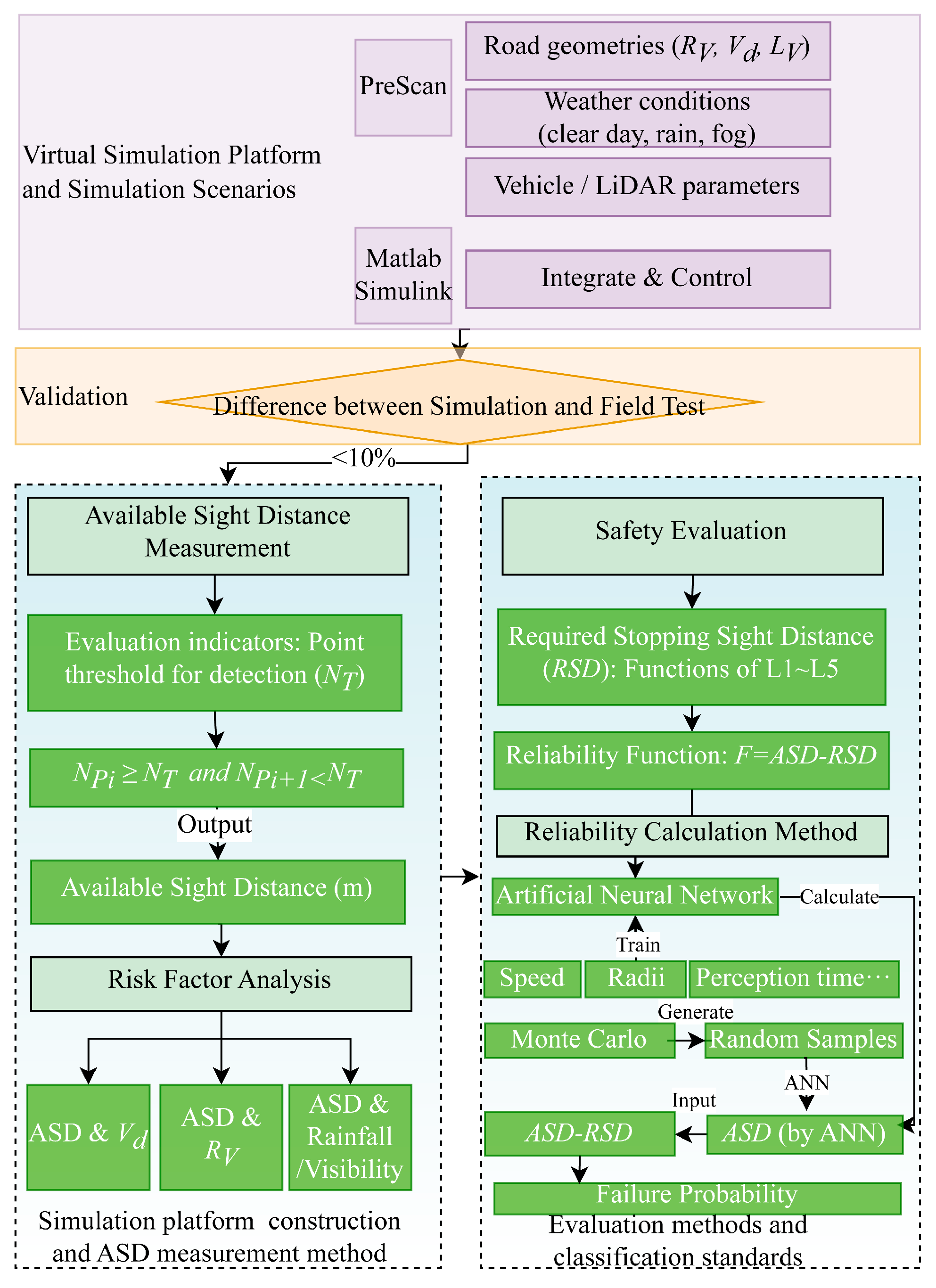
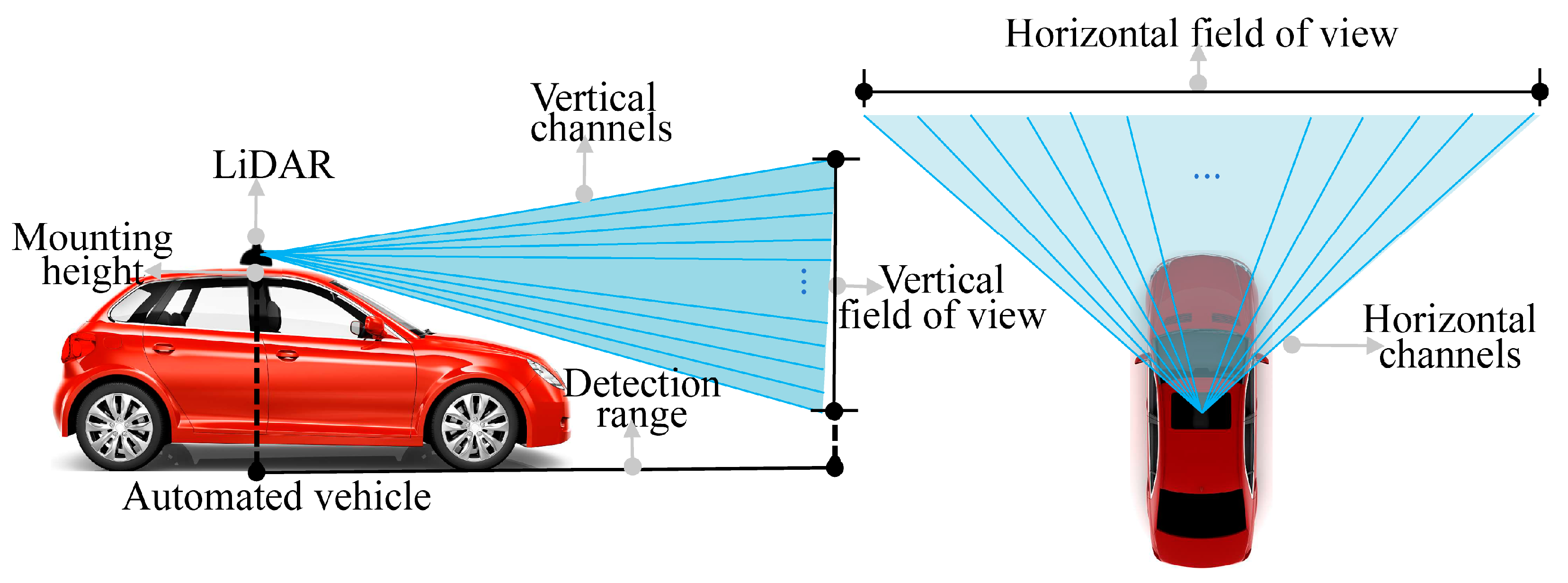


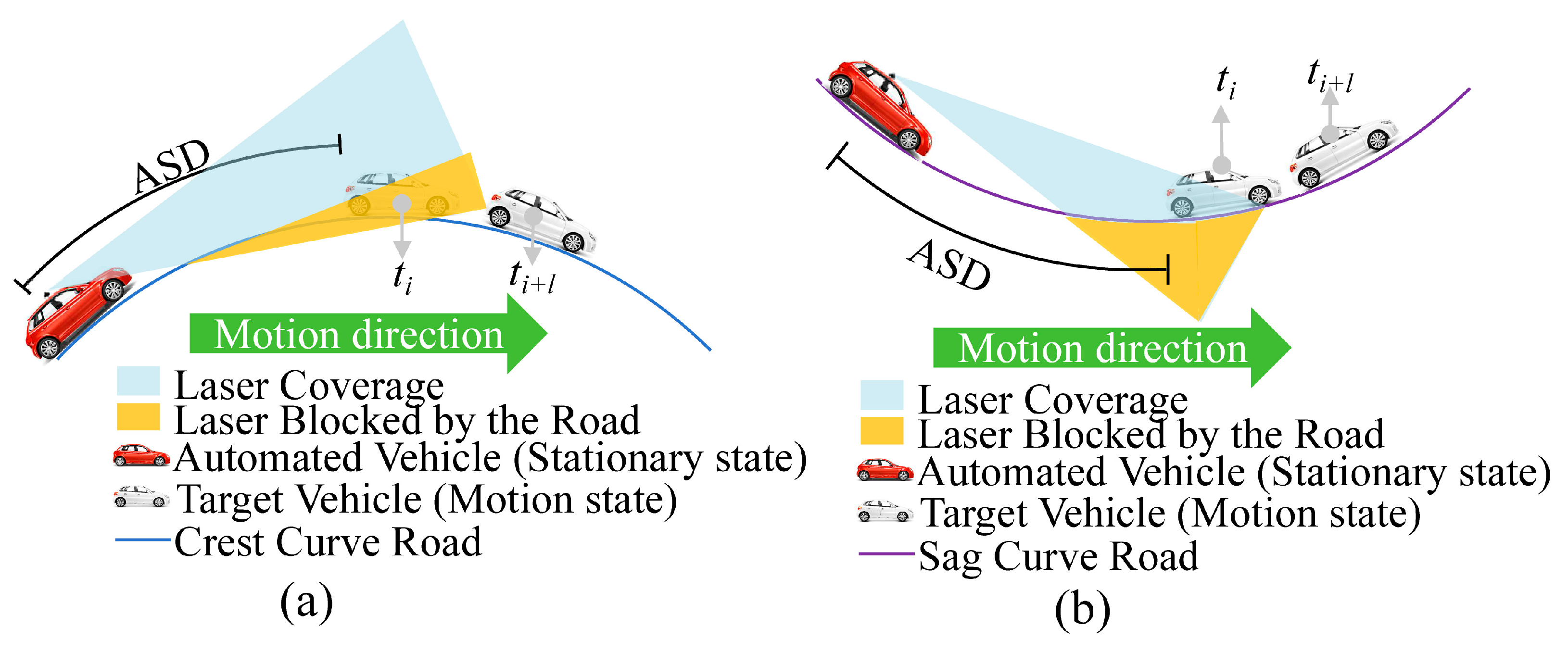


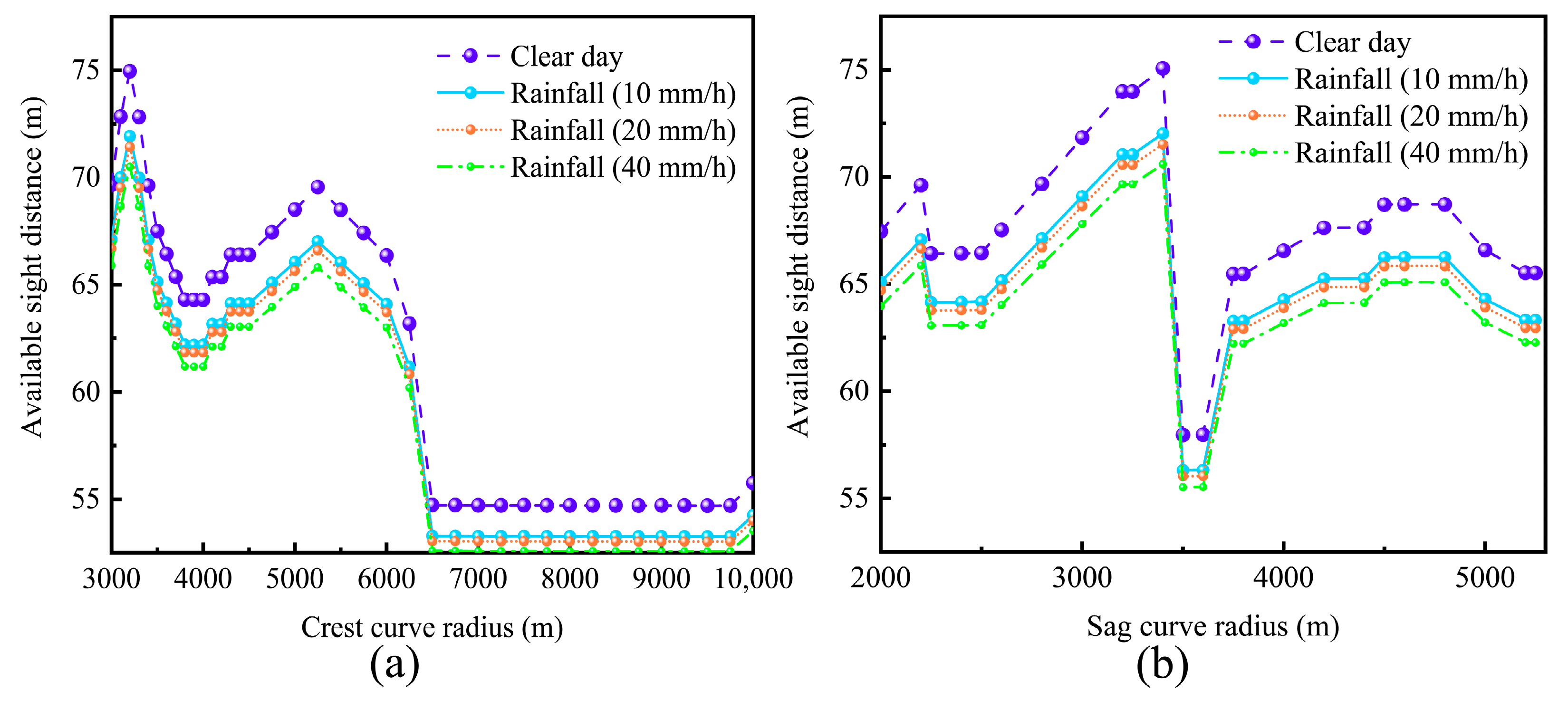
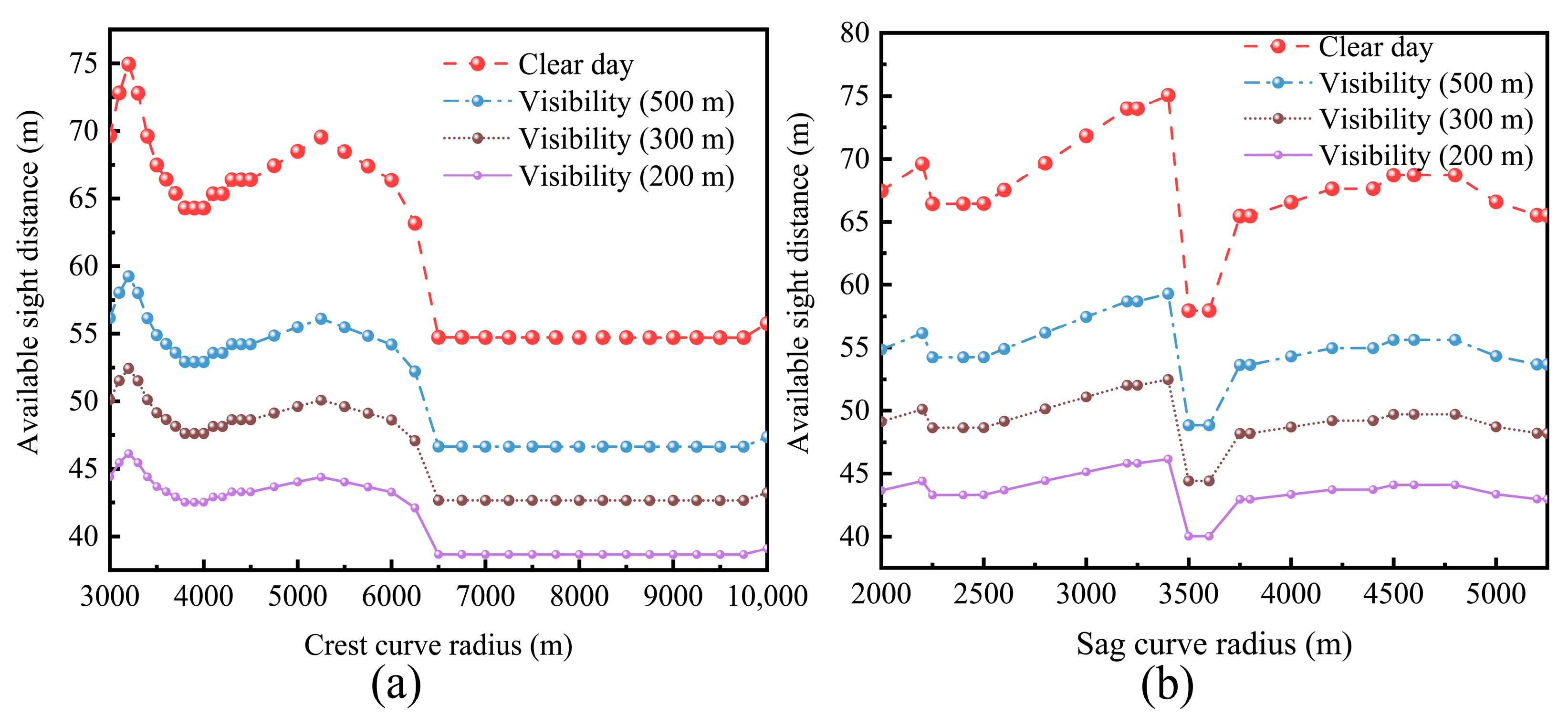
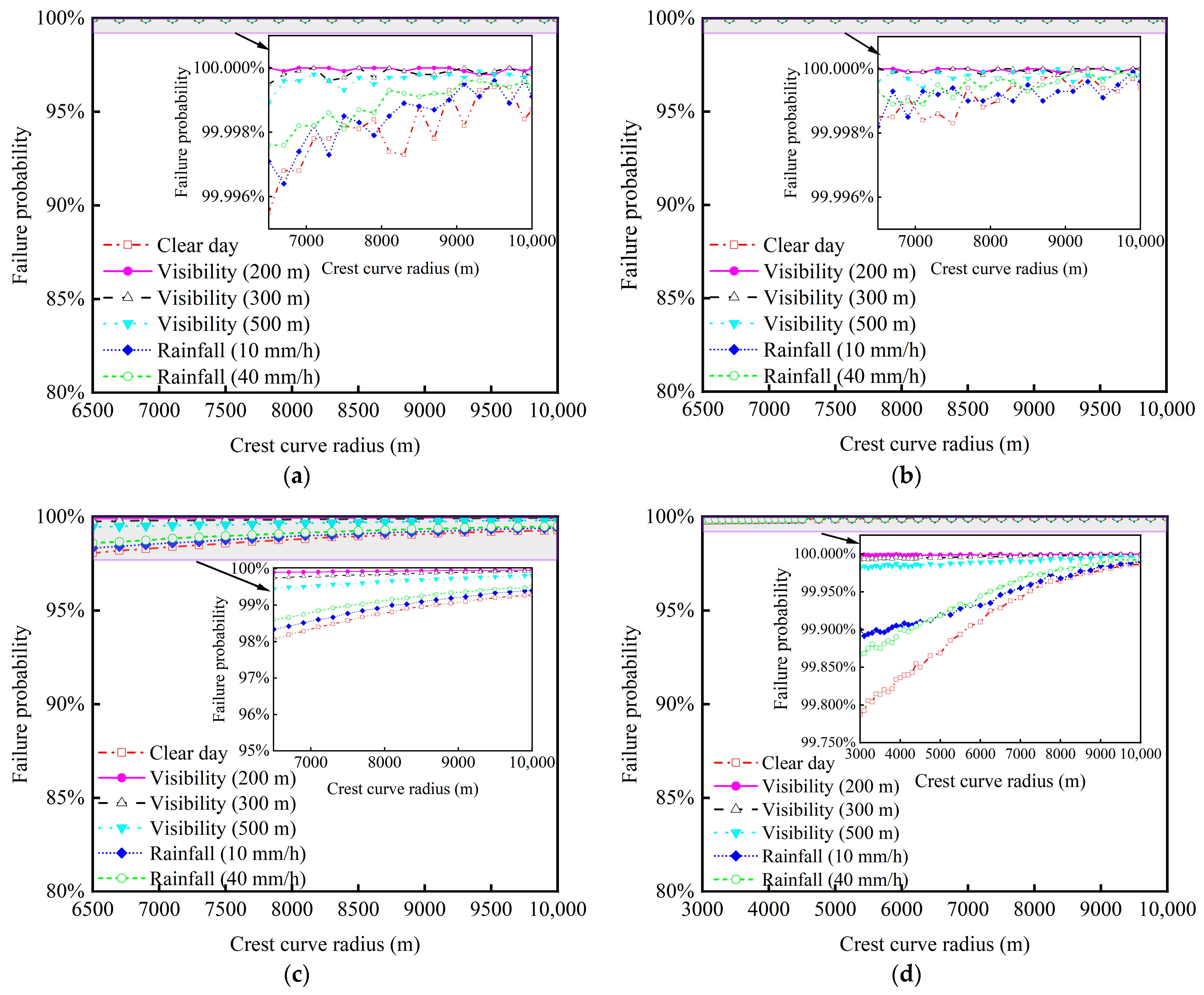
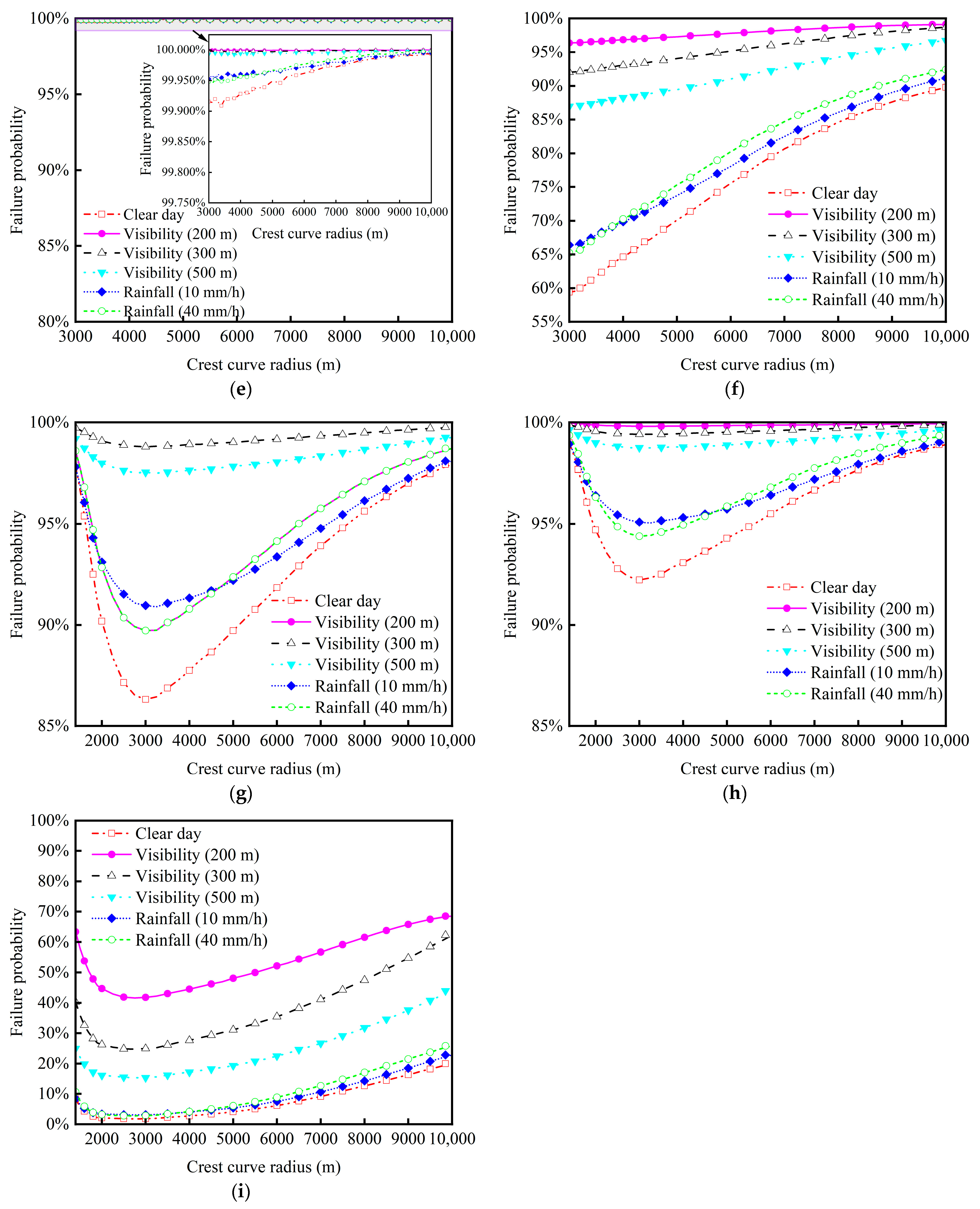
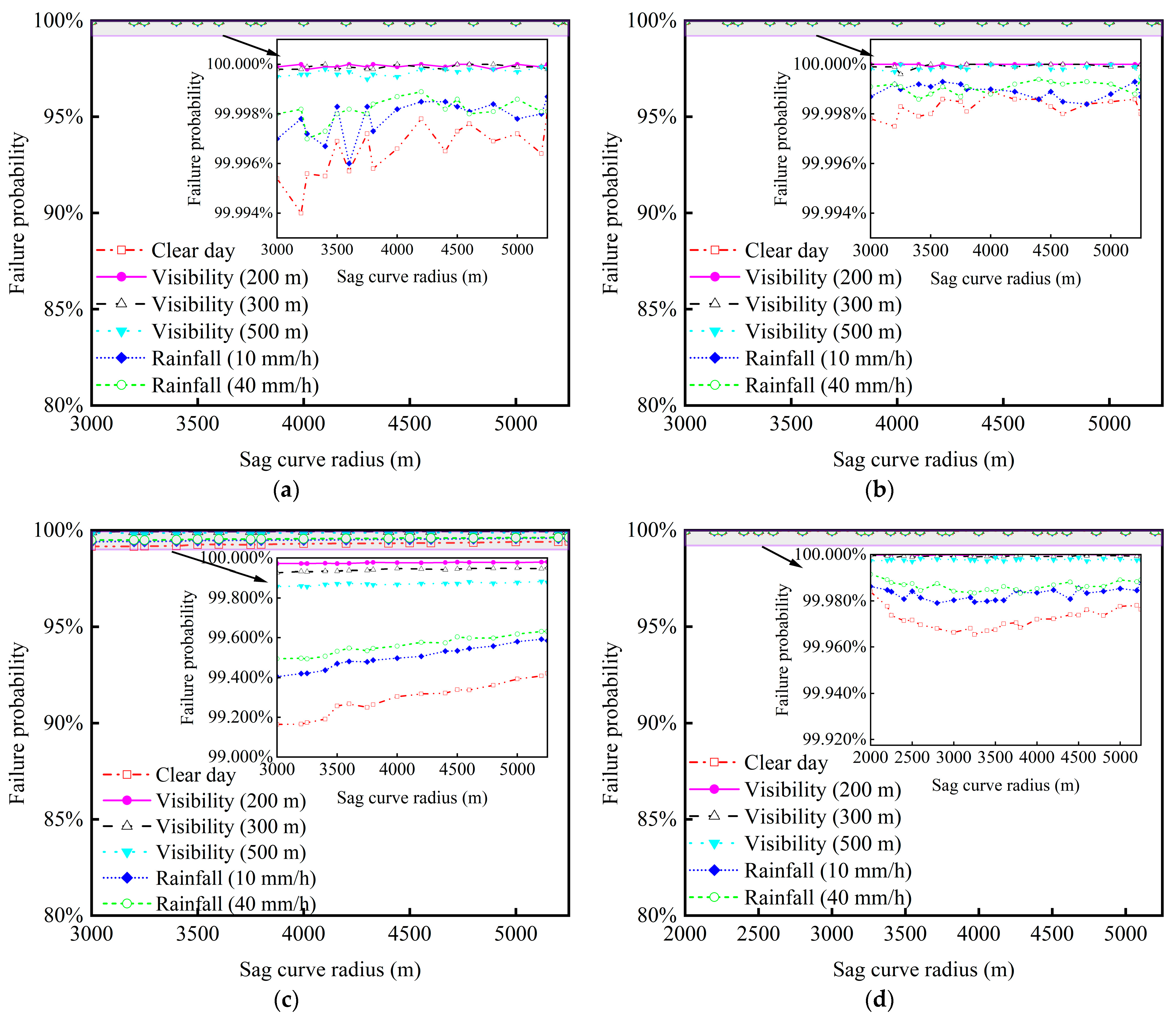
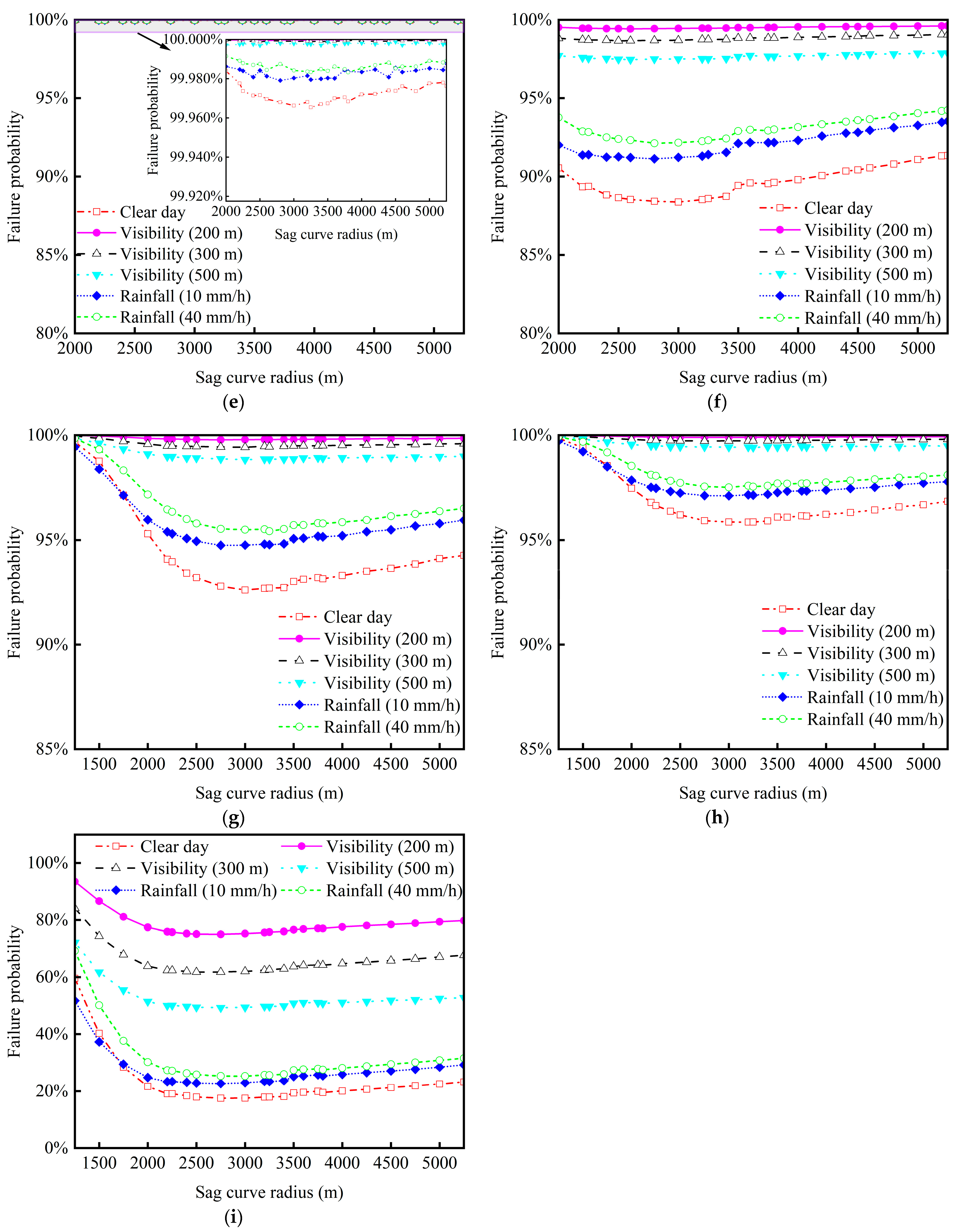
| Technical Parameters | Value |
|---|---|
| Range | 200 m |
| Frame rate | 20 Hz |
| Horizontal field of view | 120° (−60°~+60°) |
| Horizontal angular resolution | 0.40° |
| Number of channels | 300 |
| Vertical field of view | 30° (−15°~+15°) |
| Vertical angular resolution | 0.47° |
| Height | 1.40 m |
| Vertical Curve Type | 40 km/h | 60 km/h | 80 km/h | 100 km/h | |
|---|---|---|---|---|---|
| Crest curve radius | LCV (m) | [35, 400] | [56, 400] | [120, 400] | [260, 400] |
| RCV (m) | [875, 10,000] | [1400, 10,000] | [3000, 10,000] | [6500, 10,000] | |
| Sag curve radius | LSV (m) | [35, 210] | [50, 210] | [80, 210] | [120, 210] |
| RSV (m) | [875, 5250] | [1250, 5250] | [2000, 5250] | [3000, 5250] | |
| Weather Type | Rainfall Rate (mm/h) | Visibility (m) |
|---|---|---|
| Clear day | - 1 | - |
| Rain | 10 mm/h | - |
| 20 mm/h | - | |
| 40 mm/h | - | |
| Fog | - | 500 m |
| - | 300 m | |
| - | 200 m |
Disclaimer/Publisher’s Note: The statements, opinions and data contained in all publications are solely those of the individual author(s) and contributor(s) and not of MDPI and/or the editor(s). MDPI and/or the editor(s) disclaim responsibility for any injury to people or property resulting from any ideas, methods, instructions or products referred to in the content. |
© 2024 by the authors. Licensee MDPI, Basel, Switzerland. This article is an open access article distributed under the terms and conditions of the Creative Commons Attribution (CC BY) license (https://creativecommons.org/licenses/by/4.0/).
Share and Cite
Cai, M.; Mao, C.; Zhou, W.; Yu, B. Neural Network-Driven Reliability Analysis in Safety Evaluation of LiDAR-Based Automated Vehicles: Considering Highway Vertical Alignments and Adverse Weather Conditions. Electronics 2024, 13, 881. https://doi.org/10.3390/electronics13050881
Cai M, Mao C, Zhou W, Yu B. Neural Network-Driven Reliability Analysis in Safety Evaluation of LiDAR-Based Automated Vehicles: Considering Highway Vertical Alignments and Adverse Weather Conditions. Electronics. 2024; 13(5):881. https://doi.org/10.3390/electronics13050881
Chicago/Turabian StyleCai, Mingmao, Chengyang Mao, Wen Zhou, and Bin Yu. 2024. "Neural Network-Driven Reliability Analysis in Safety Evaluation of LiDAR-Based Automated Vehicles: Considering Highway Vertical Alignments and Adverse Weather Conditions" Electronics 13, no. 5: 881. https://doi.org/10.3390/electronics13050881
APA StyleCai, M., Mao, C., Zhou, W., & Yu, B. (2024). Neural Network-Driven Reliability Analysis in Safety Evaluation of LiDAR-Based Automated Vehicles: Considering Highway Vertical Alignments and Adverse Weather Conditions. Electronics, 13(5), 881. https://doi.org/10.3390/electronics13050881






